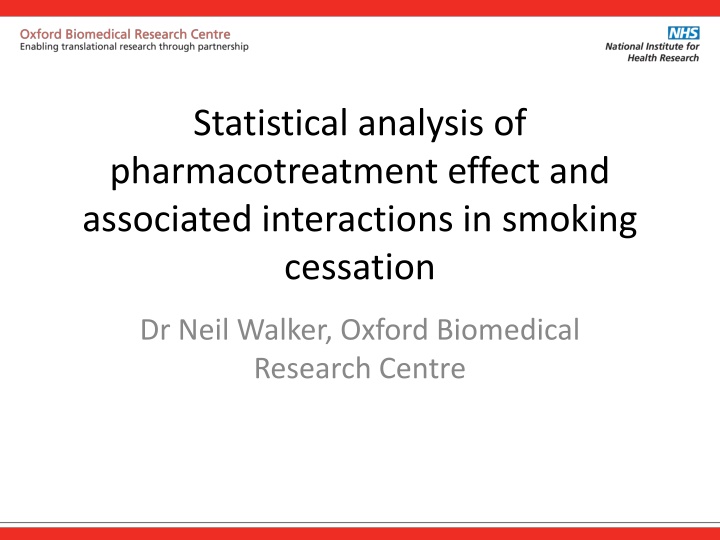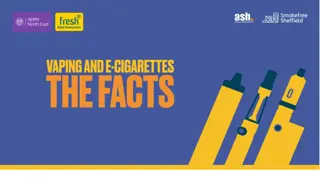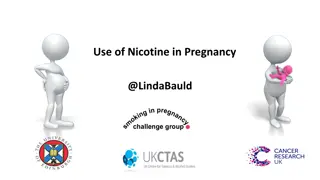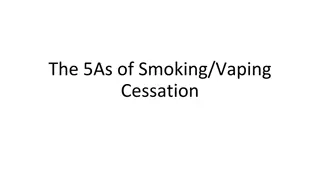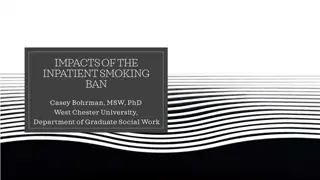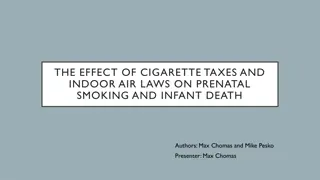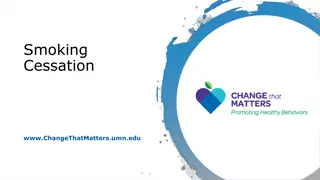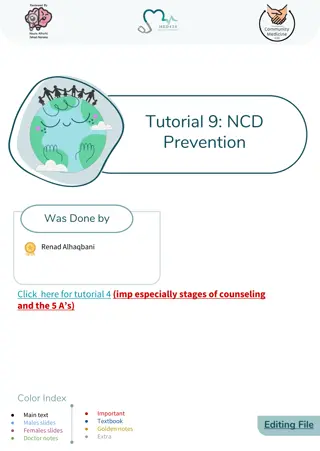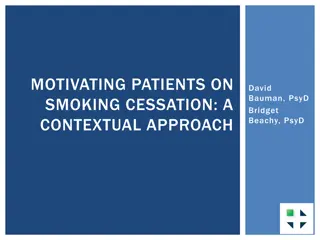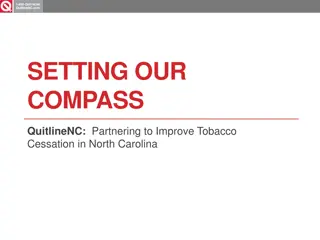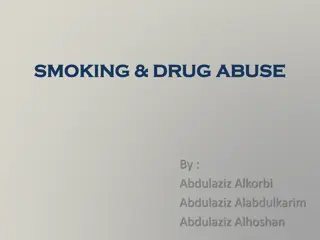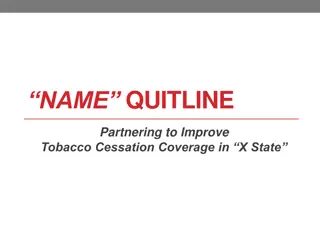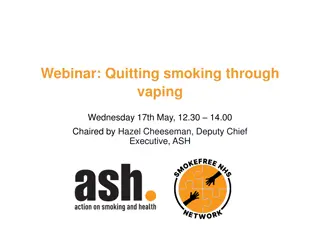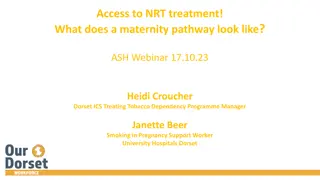Statistical Analysis of Pharmacotreatment Effect in Smoking Cessation
This study by Dr. Neil Walker at the Oxford Biomedical Research Centre aims to analyze the effectiveness of pharmacotreatment in smoking cessation using observational data from the Stop Smoking Service. The research evaluates the impact of medications like Champix, Zyban, and Nicotine Replacement Therapy on quitting rates, identifying subgroups that benefit most from specific treatments. The Quit Manager database provides electronic tracking of patient outcomes at various intervals post-treatment. The study also explores real-world data from the Quit-51 program to assess smoking quit rates and factors influencing outcomes in a practical setting. NCSCT-accredited treatment program offers a 12-week structured approach for smokers seeking to quit.
Download Presentation

Please find below an Image/Link to download the presentation.
The content on the website is provided AS IS for your information and personal use only. It may not be sold, licensed, or shared on other websites without obtaining consent from the author.If you encounter any issues during the download, it is possible that the publisher has removed the file from their server.
You are allowed to download the files provided on this website for personal or commercial use, subject to the condition that they are used lawfully. All files are the property of their respective owners.
The content on the website is provided AS IS for your information and personal use only. It may not be sold, licensed, or shared on other websites without obtaining consent from the author.
E N D
Presentation Transcript
Statistical analysis of pharmacotreatment effect and associated interactions in smoking cessation Dr Neil Walker, Oxford Biomedical Research Centre
Objectives Use observational data (Stop Smoking Service) to: Make inference on effectiveness of pharmacotreatment in smoking cessation Identify subgroups (demographic or treatment regime) who perform strongly with particular treatments
Stop Smoking Service 12 week programme offered to smokers wanting to quit throughout UK. Programme of meetings, max=12 (face-to-face, group session, telephone conversations) Initial assessment (smoking patterns, motivation) to tailor programme to individual needs Medication: Nicotine Replacement Therapy (NRT), Champix and Zyban Follow-up sessions: progress, medication, encouragement
Quit Manager database Electronic system for tracking patients using Stop Smoking Service: Standard personal & demographic information (name, DOB, address ) Session information (date, duration etc) Outcome recorded at 4,12,26 & 52 weeks (increasing number lost to follow-up at later times) Anonymised data extracted from Quit Manager for current analysis
Pharmacotreatment Champix (Varenicline) prescribed course of tablets, proven efficacy in RCTs. Mode of action: Nicotine receptor partial agonist. Zyban (Bupropion) prescribed tablets. Mode of action: Norepinephrine-dopamine Reuptake Inhibitor (NDRI). Nicotine Replacement Therapy (NRT) available over the counter/on prescription. Patches, typically in combination with oral product (chewing gum, nasal spray etc).
Observational data Data provided by Quit-51: operate a number of Stop Smoking Services in England Data recorded on patients attempting to quit through Stop Smoking Service Opportunity to analyse a large observational dataset: Can assess smoking quit rates and association with wide range of potential explanatory variables in real world setting
Stop Smoking Service treatment programme NCSCT accredited 12-week programme. Includes: Sessions with NCSCT-accredited adviser(s) Initial assessment to establish suitable programme Quit date agreed ( Not a puff criteria) Weekly/fortnightly follow-up sessions (medication, monitor progress, encouragement)
Quit Manager Patient s progress recorded electronically; Patient details (name, DOB, medical history etc) Details on individual sessions Outcomes (quit success/failure) recorded at 4, 12, 26 & 52 weeks Patient data (anonymised) extracted to create database for analysis
DATA Data from 10 PCTs: London (Havering [2011-2014], Redbridge [2004-2014], Waltham Forest [2012-2013], Barking & Dagenham [2010-2015]). Sussex (East Sussex Downs and Weald [2002-2015], Hastings and Rother [2006-2015]) West Midlands (Sandwell [2013-2015], Walsall Teaching [2014- 2015], Telford and Wrekin [2013-2015], Worcestershire [2013- 2015]) N=89740 in total
Quantitative + qualitative information Has patient managed to quit? Self-report at 4 weeks then at 12, 26 & 52 weeks. CO validation at 4 weeks (i.e. CO < 10 ppm) Standard demographic information: Age, Sex, Occupation Service used: Group, one-to-one with adviser, treatment prescribed
Statistical models Want to identify factors (treatment & other things) which influence the probability of a successful quit Response variable y: some measure of quit success (0/1). Use 4- week valid DH quit (quit according to Russell standard) for y. Mixed Model method, GLMM (fixed + random effects) Explanatory variables: Fixed effects pharmacotreatment (Champix, NRT, Zyban, no treatment) + age, sex & type of service used. Random effects PCT + adviser. Binary response (0/1) quit success analysed on logit scale. Logit (P) = log ( (1 ?)) where P = the probability of a successful outcome (quit) ?
Statistical models 1. Main effects: Assess overall effects of explanatory variables. Logit(y) = Treatment + Age + Sex + Service 2. Treatment interactions: Do treatments benefit particular subgroups? Logit(y) = Treatment + Age + Sex + Service + Treatment*Age + Treatment*Sex + Treatment*Service
RESULTS Raw data quit rate by pharmacotreatment 4-week quit rate (%) by pharmacotreatment 100 90 80 70 60 % quit rate 50 40 30 20 10 0 no treatment specified (n=6492) Champix (n=13593) NRT (n=35650) Zyban (n=443)
RESULTS Raw data quit rate by age 4-week valid DH quit rate (%) by age 100 90 80 Percentage quit rate 70 60 50 40 30 20 10 0 15 20 25 30 35 40 45 Age (yrs) 50 55 60 65 70 75 80
RESULTS Raw data quit rate by service used 4-week valid DH quit rate (%) by age 100 90 80 70 % quit rate 60 50 40 30 20 10 0 Drop In GP Practice Group One to One Pharmacy Telephone Workplace Service
RESULTS Main effects GLMM Raw data Model statistics Wald-stat (df) Variable Levels n quit / n total (% quit rate) (logit scale) p-value Sex 10.6 (1,40518.9) 0.001 male 20012/26491 (75.5%) 0 female 21713/29684 (73.1%) -0.080 10.6 (1,40518.9) 0.001 Age Category 192.1 (2,40440.1) <0.001 13-19 20-29 30+ 1168/2258 (51.7%) 6120/8518 (71.8%) 34439/45402 (75.9%) 0 +0.56 +0.78 73.5 (1,40331.6) 165.6 (1,39938.2) <0.001 <0.001 Service Used Treatment 69.5 (7,21886.2) 233.9 (3,39285.9) <0.001 <0.001 No treatment specified Champix 5093/6492 (78.5%) 0 10969/13593 (80.7%) +0.34 36.7 (1,35716.3) <0.001 NRT 25329/35650 (71.0%) -0.14 7.6 (1,33938.6) 0.006 Zyban 336/443 (75.8%) +0.18 1.5 (1,40644.1) 0.2
RESULTS Interactions GLMM (interactions only) Interaction Level (logit scale) - - - - -0.17 - - Wald-stat (df) p-value NRT*Age Category Champix* Age Category Zyban* Age Category NRT* Sex 1.6 (2,40468.5) 3.8 (2,40380.2) 0.01 (2,40079.1) 5.2 (1,40320.4) 0.4 0.2 0.997 0.02 NRT*female Champix* Sex Zyban* Sex NRT* Service Used 0.4 (1,40313.2) 0.4 (1,40177.0) 33.8 (7,39177.3) 0.5 0.5 <0.001 NRT*drop-in NRT*GP NRT*group NRT*one-to-one NRT*pharmacy NRT*telephone service NRT*workplace NRT*unknown 0 -0.30 0 -0.40 +0.14 -1.48 +0.10 -0.26 - - Champix* Service Used Zyban* Service Used - - 5.3 (5,40228.1) 0.4
RESULTS NRT * Sex interaction, raw data Valid DH quit rate (weeks) by sex and NRT group 85 83 81 79 77 % quit rate NRT (no) 75 NRT (yes) 73 71 69 67 65 Male Female
RESULTS NRT * service, raw data Valid DH quit rate (weeks) by service and NRT group 100 90 80 70 60 50 NRT (no) NRT (yes) 40 30 20 10 0 Drop In GP Practice Group One to One Pharmacy Telephone Service Workplace unknown
Inference main effects Statistical evidence of effects associated with: Pharmacotreatment highest quit rates seen in patients using Champix Sex Men using stop smoking service are more likely to quit Age low quit rates among young smokers, flattens off with increasing age Service used statistical evidence that the type of service used can influence chance of successful quit (Group sessions most effective)
Inference - interactions Patients using NRT have lower chance of quitting than on other regimes this particularly pronounced in females Some evidence that effectiveness of NRT varies according to programme regime (positive interaction with pharmacy & workplace , negative in conjunction with telephone service ).
Conclusions Statistical evidence in real world setting to support the use of Champix as an aid to smoking cessation. Quit rate associated with NRT low in relation to other treatments. This particularly so for women. Evidence that effectiveness of NRT can be enhanced in combination with particular treatment programmes. Quit rate low in young age group, rises sharply up to approximately 30 years, then flattens. No statistical evidence for interaction between age and treatment(s) though. Data from 10 PCTs can we generalise results to rest of UK? Haven t taken into account the different costs of treatments
Further Work Interactions between treatment & other factors Geographical differences? Using later time points (12,26, 52 weeks) for analysis (but data more scarce) How results compare to RCTs Non-linear modelling of age
Thank you, merci, grazie, obrigado Thanks to Emma Croghan and Hayley Bates (North-51) for providing the data. Email: Neil.Walker3@ouh.nhs.uk
